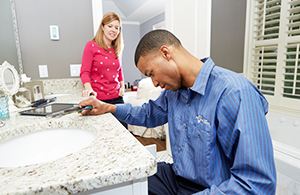Getting Acquainted with Home Plumbing Basics: A Beginner's Handbook
Getting Acquainted with Home Plumbing Basics: A Beginner's Handbook
Blog Article
The publisher is making a number of great annotation relating to Understanding the Basics of Your Home's Plumbing System as a whole in the content on the next paragraphs.

Plumbing is an important facet of any type of home, responsible for providing clean water for drinking, food preparation, and showering, in addition to removing wastewater securely. Comprehending the basics of home plumbing is crucial for every single home owner to make certain appropriate maintenance, troubleshooting, and, if necessary, repairs. In this newbie's guide, we'll cover the basic concepts of home plumbing to aid you become extra accustomed to exactly how it functions.
Water Heater
The water heater is accountable for home heating water for domestic use, consisting of bathing, food preparation, and cleansing. Common kinds of hot water heater include tank-type water heaters, tankless (on-demand) hot water heater, and heat pump water heaters. The hot water heater is connected to the water system system and supplies hot water to plumbing fixtures as needed.
Water drainage System
The drainage system eliminates wastewater from your home and lugs it away to a sewer treatment facility or septic tank. It contains a network of pipes, fittings, and fixtures that carry wastewater from plumbing components to the major sewer line or sewage-disposal tank. Correct drainage is necessary to stop obstructions, back-ups, and sewer leakages.
Ventilation System
The ventilation system helps preserve correct atmospheric pressure and prevent sewer gases from entering your home. Vent pipes, also referred to as air vent stacks, expand from plumbing components to the roofing system, enabling sewage system gases to run away securely outside. Air flow pipes additionally allow air to enter the water drainage system, facilitating smooth wastewater flow and stopping suction or vacuum cleaner results.
Water Supply System
The water system system brings clean water into your home from a local water source or a personal well. It includes a primary water line that links to your home's plumbing system, generally situated underground. A water meter gauges the quantity of water taken in, while a shut-off valve enables you to manage the flow of water into your home.
Plumbing Fixtures
Plumbing components are tools that supply water to different parts of your home and include sinks, taps, commodes, showers, tubs, and home appliances such as dishwashing machines and washing machines. Each component is attached to the water system system by means of pipes and installations and might have its shut-off valve for maintenance or emergency situations.
Usual Plumbing Tools
Having the right tools accessible is crucial for executing fundamental plumbing repairs and upkeep tasks. Common plumbing devices include adjustable wrenches, monkey wrench, pliers, pipe cutters, hacksaws, plungers, augers (or drainpipe snakes), and Teflon tape. Having these devices conveniently offered can help you tackle small plumbing issues successfully.
Standard Plumbing Repair Services
While some plumbing repair work may need specialist help, numerous common concerns can be attended to with standard DIY strategies. Discovering how to deal with a leaking tap, unblock a drain, change a bathroom flapper, or fix a leaking showerhead can conserve you time and money on plumbing fixings.
Final thought
Recognizing the basics of home plumbing is necessary for every home owner to maintain a risk-free, useful, and effective plumbing system. By acquainting yourself with the water system system, plumbing components, drainage system, ventilation system, common plumbing devices, and fundamental fixings, you can confidently resolve minor plumbing issues and guarantee your home's plumbing system runs efficiently.
Understanding Basics of Home Plumbing System: A Beginner's Guide
The Main Components of Your Home Plumbing System
The Water Supply System
This system is responsible for transporting fresh water into your home. It usually has a main water line that splits into two branches: one directed towards cold water services and the other connected to a water heater for hot water. The pressure is key here; it ensures water reaches all parts of your house.
The Drainage System
Once water has been used, it becomes wastewater that needs to be removed from your home. This is where the drainage system comes into play. It includes all the pipes that carry wastewater and sewage away from your house to sewage treatment facilities or septic tanks.
The Vent System
The vent system prevents sewer gases from entering your home and helps maintain the pressure balance that allows wastewater to flow out properly. These vents usually exit through the roof of your house.
Water Heating System
For those who enjoy hot showers or using hot water for cleaning, the water heater is a crucial part of the plumbing system. It can be a tankless system, which heats water on demand, or a traditional water tank model.
Common Plumbing Problems and Basic Troubleshooting
Plumbing systems, while designed to be durable, can face issues like clogged drains, leaky faucets, or low water pressure. Here are some basic troubleshooting tips:
Clogged Drains
Use a plunger or a plumber's snake to try and dislodge whatever is blocking the drain. Regular cleaning can prevent clogs.
Leaky Faucets
Often caused by worn-out washers or gaskets, these can usually be replaced by someone with basic DIY skills.
Low Water Pressure
This might be due to sediment build-up in your fixtures or a leak somewhere in your water line. Cleaning out aerators or seeking a professional to detect leaks might be necessary.
Preventive Maintenance Tips
Maintaining your plumbing system is key to avoiding emergencies. Regularly check for leaks, avoid disposing of grease down the sink, and have your system inspected by a professional plumber at least once a year.

Hopefully you enjoyed our excerpt on How Does the Plumbing Work in Your Home?. Thanks a ton for taking time to read through our blog. You should take the opportunity to distribute this article if you liked it. Thank you so much for your time spent reading it.
Call Report this page